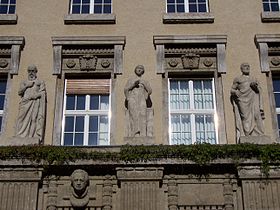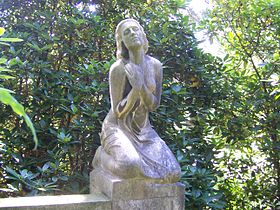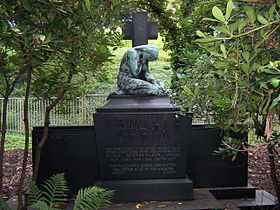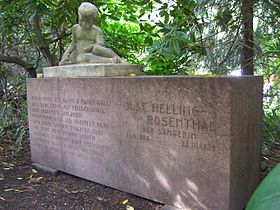Felix Pfeifer
Felix Georg Pfeifer (born November 9, 1871 in Leipzig ; † March 6, 1945 there ) was a German sculptor and medalist .
Life path
family
Felix grew up as the third son of six children of the Leipzig merchant Friedrich Eduard Pfeifer and his wife Florentine Henriette, née Sperling, in a middle-class family. In 1906 he married the daughter of a businessman and a graduate of the Leipzig teacher training college Johanna Helene Brachmann (1883–1963) in Dresden . The marriage had two children, daughter Regina and son Peter.
education
From Easter 1890 to 1893 he studied at the Leipzig Art Academy with Melchior zur Strasse , then switched to Peter Breuer and Ernst Herter at the Berlin-Charlottenburg Art Academy in 1894 , and finally completed his training through study visits to Rome (1895-1896) - where he worked with the Circle around Eugen Diederichs came into contact - and Paris (1900) to complete. After he had stayed in Dresden from 1906 to 1911 for artistic perfection and was a member of the Elbier and founding member of the Dresden Artists' Association , he finally settled as a freelance sculptor in Leipzig, where he was appointed professor in 1914.
Creating art
At the Dresden art exhibition of 1901, his 17 exhibits were recognized by portrait plaques. In the same year he created the plaque for the 300th anniversary of the discovery of the mineral springs of Salzbrunn in Silesia.
Inspired by the literary work of Richard Dehmel , Pfeifer repeatedly dealt with the subject of the relationship between two people in his sculptural works. His first group of sculptures, First Love , already achieved great success . Their purchase by the Saxon state was the prelude to a whole series of important commissions for the young sculptor. So he furnished the choir of the Nikolaikirche in Leipzig with four large alabaster reliefs. The reliefs on the main portal of the New Town Hall and the facade figures Philosophy , Industry and Medicine above the entrance to the Deutsche Bücherei in Leipzig are also by his hand. His daughter Regina was the model for the fountain figure girl with frog in the foyer of the Deutsche Bücherei.
Pfeifer created the medal from 1914 for the 150th anniversary of the Leipzig Art Academy (now the University of Graphic and Book Art Leipzig ).
One of his main works, the sculpture Sehnsucht , combines classic forms with a modern motif of movement. The female terracotta bust from 1915 in the Leipzig Museum of Fine Arts contains "that naturalistic, extremely sparing view, deeply rooted in psychology, for which Pfeifer's portrait busts of leading heads of Leipzig's intellectual life were particularly appreciated."
A cast of the original 1927 for the ornamental fountain in front of the building of the General Local Health Insurance Leipzig created figure recovery was on the occasion of 1936 in Dresden held Reichsgartenschau placed at flower plan the calibration meadow. At that time the name of the plastic was blissful beauty . Today this plant is in the rose garden . On the plaque in the lawn in front of the sculpture you can read that this figure is a gift from the widow to the city of Dresden. "In sculpture, his neoclassical style between tradition and modernity contributed to the clarification of forms, renewed plastic severity and a conscious body perception."
In addition to freestanding and building sculptures in the Leipzig area, his achievements in the field of relief, medal and plaque art are to be emphasized. In the vernacular, he was therefore quite respectfully called "plaque piper". Initially committed to a strictly flat, linear Art Nouveau style (relief tomb Walter Queck ), he succeeded, following on from the French medalists Alexandre Charpentier , Dupuy and Roty, with a delicate, painterly relief style and his special talent, emotional moods and strong characterization in his portraits to let go of supra-regional importance. “When it comes to proclaiming the fame of the Leipzig plaque makers and medalists, Felix Pfeifer must be mentioned first. (...) Now he is one of the best relief sculptors Germany has to offer. "
Design drafts for furniture and household items are also known by his hand.
The artist, who lived in a villa in Großdeuben and worked in Leipzig, died in an accident, he was killed by a clay model in the studio.
Individual works (selection)
plastic
- 1899: First love, marble group
- 1890: The Kiss, marble group
- 1903: Kaiser Friedrich Memorial, Misdroy
- 1904–1905: Four altar reliefs, Nikolaikirche Leipzig
- 1906: Athena, marble, sculpture collection, Staatliche Kunstsammlungen Dresden
- 1906: Reliefs on Walter Queck's tomb , granite, Leipzig Südfriedhof
- 1910: Barbara-Uthmann-Brunnen , Elterlein in the Ore Mountains
- 1910: Bacchants, bronze sculpture, Museum of Fine Arts, Leipzig
- 1912: Boy playing the flute, bronze sculpture, Museum of Applied Arts, Leipzig
- 1912: father with daughter, bronze sculpture
- 1913: Male facade sculptures, frog fountain in the foyer, reliefs of Kaiser Wilhelm II and King Friedrich August III. (Reliefs removed), Deutsche Bücherei , Leipzig
- 1913: Female torso, marble, Museum of Fine Arts, Leipzig
- 1915: Longing , white Lasa marble, tinted hair, with gold plating, Federal Academy for Public Administration , Boppard (loan from the MbK, Leipzig)
- 1915: Female bust, terracotta, Museum of Fine Arts, Leipzig
- 1916: Portrait medallion grave Schmacht, bronze, Südfriedhof Leipzig
- 1916: Icarus, bronze, Museum of Fine Arts, Leipzig
- 1918: Kneeling Girl (Melusine), bronze, Museum of Fine Arts, Leipzig
- 1918: Tomb for Karl Lamprecht , Schulpforta
- 1919: War memorial in Warenthin
- 1919: Tomb family Bauch, granite / bronze, Ohlsdorf cemetery , Hamburg
- 1922: Female torso, marble, Museum of Fine Arts, Leipzig
- 1923: Memorial in the Leipzig Graduate School of Management and in the Arionenhaus Leipzig
- 1924: Hugo Gaudig's tomb, Neuer Johannisfriedhof Leipzig
- 1925: Kleim tomb, Leipzig south cemetery
- 1925: embrace, marble
- 1925: Bacchic dancer, bronze
- 1925: Melusine, bronze
- 1927: Recovery, fountain figure in ore in front of the building of the Allgemeine Ortskrankenkasse , Leipzig
- 1928: Portrait relief Otto Wiener , bronze
- 1929: The Negro Dancer, bronze, Museum of Fine Arts, Leipzig
- 1930: Rising youth, marble, tomb of the Scutari family, Leipzig south cemetery
- 1931: Monument to the fallen in Zwenkau
- 1932: Mourners, marble, Franz Wendt grave, Leipzig south cemetery
- 1937: Angels, marble, Haertel-Kipke tomb, Leipzig south cemetery
- 1939: Boy with nightingale, marble, Ilse Helling-Rosenthal tomb , Leipzig south cemetery
- 1939: Mother with children, bronze, Bitterfeld cemetery
- Three works, Danae , Nichide and Weiblicher Torso , were donated by the widow to the Lindenau Museum in Altenburg .
Busts
- 1920: Hugo Gaudig , marble
- 1929: Wolfgang Amadeus Mozart , monumental bust, marble, foyer of the Leipzig Opera
- 1931: Johannes Brahms and Anton Bruckner , monumental busts, marble, Gewandhaus Leipzig
- 1933: Rudolf Freiherr von Seckendorff , Museum of Fine Arts, Leipzig
- More portrait busts of:
Wilhelm Wundt , Hans Driesch , Theodor Kölliker , Johannes Volkelt , Georg Witkowski , Maria Ney , Paul de Lagarde , Ludwig van Beethoven , Johann Wolfgang von Goethe , Johann Friedrich August Olearius
Badges and medals (selection)
- 1902: Max Klinger
- 1905: Wilhelm Wundt , bronze plaque
- 1911: Max Reger
- 1912: Heinrich Ritter
- 1914: 150 years of the Royal Academy of Arts, Leipzig
- 1914: International exhibition for the book trade and graphics
- 1920: Hugo Gaudig
- 1922: Gerhart Hauptmann
- 1924: Johann Heinrich Rille
- 1927: Wilhelm Roux
- 1930: Johannes Gebbing
- Other small bronzes, plaques and medals can be found in the Dresden, Berlin , Leipzig, Bremen and Hanover collections .
literature
- Herwig Guratzsch (Ed.): Museum of Fine Arts Leipzig. Catalog of sculptures. Cologne 1999.
- Alfred E. Otto Paul: The art in silence. Art treasures in Leipzig cemeteries. Vol. 1–4, Leipzig 2009–2011.
Individual evidence
- ^ L. Forrer: Biographical Dictionary of Medallists . Pfeifer, Felix in: Volume IV. Spink & Son Ltd, London 1909, p. 474 .
- ↑ Cf. Alfred E. Otto Paul: The art in stillness. Art treasures in Leipzig cemeteries. No. 3, Leipzig 2010, p. 100.
- ^ L. Forrer: Biographical Dictionary of Medallists . Pfeifer, Felix in: Volume VIII. Spink & Son Ltd, London 1930, p. 123 .
- ↑ Herwig Guratzsch (Ed.): Museum of Fine Arts Leipzig. Catalog of sculptures. Cologne 1999, p. 58.
- ^ Horst Riedel: Stadtlexikon Leipzig from A to Z. Leipzig 2005.
- ^ Albrecht Kurzwelly: Leipziger Kunstgewerbe. In: Kunstgewerbeblatt. NF 18, 1906, H. 3. Quoted from: Herwig Guratzsch (Hrsg.): Museum der bildenden Künste Leipzig. Catalog of sculptures. Cologne 1999
- ↑ List of monuments in Saxony-Anhalt, Bitterfeld district, Volume 13, prepared by Sabine Oszmer, Michael Imhof Verlag, Petersberg, ISBN 3-937251-53-7 , page 44
- ↑ Heinrich Ritter (1837–1917) had been with the Karl Baedeker publishing house since 1853 , became an authorized signatory in 1862 and a partner in 1878. He also edited the Baedeker travel guide .
Web links
- Literature by and about Felix Pfeifer in the catalog of the German National Library
- Athena in the Dresden Sculpture Collection
- Report on part of the artist's estate (PDF; 133 kB)
- Information about Felix Pfeifer on the website of the Rosengarten Dresden
- Works at the Great German Art Exhibition in Munich
- Report on the Gustav Kleim tomb
- Report on the tomb of Plato Scutari
| personal data | |
|---|---|
| SURNAME | Pfeifer, Felix |
| ALTERNATIVE NAMES | Pfeifer, Felix Georg |
| BRIEF DESCRIPTION | German sculptor, medalist |
| DATE OF BIRTH | November 9, 1871 |
| PLACE OF BIRTH | Leipzig |
| DATE OF DEATH | March 6, 1945 |
| Place of death | Leipzig |












